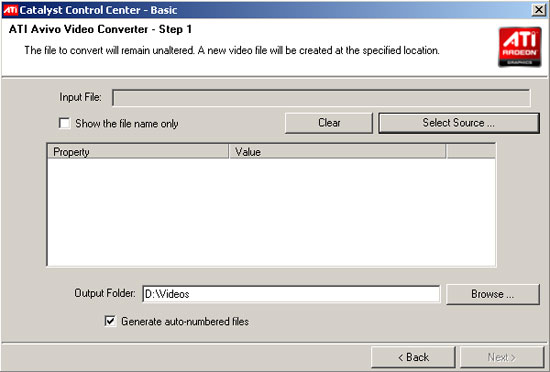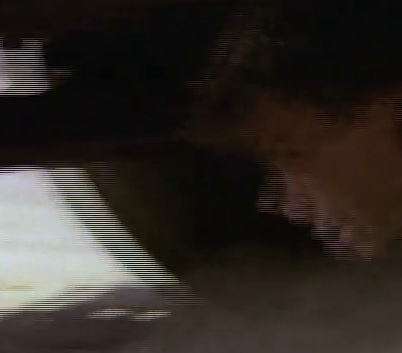AVIVO Video Converter Redux and ATI Stream Quick Look
by Derek Wilson on June 11, 2009 12:01 AM EST- Posted in
- GPUs
A few months ago, we tested AMD's AVIVO Video Converter. AMD had just enabled video transcode acceleration on the GPU, and they wanted to position their free utility as competition to CUDA enabled (and thus NVIDIA only) Badaboom. Certainly, for a free utility, we would not expect the same level of compatibility and quality as we would from a commercial application like Badaboom. But what we saw really didn't even deliver what we would expect even from a free application.
We didn't pull any punches when first we previewed Badaboom either. Their application in its original form left a lot to be desired. They took our feedback and built a product that is very workable for the purpose of quickly taking video and encoding it for use on portable devices with plenty of flexibility built in as well. After our look at AVIVO, we assumed AMD would take our feedback (and feedback from around the internet) and use it to build a better product.

We do understand the rush to get software out there that takes advantage of GPU compute capability and that video transcode is the low-hanging fruit. The first shot at anything can be rough, especially when under pressure.
AMD recently released an updated version of their transcode utility, and we were hopeful that it would deliver where its predecessor fell short. Unfortunately, we were flat out wrong.
Today, in addition to looking AMD's built in solution, we will look at Cyberlink's MediaShare Espresso to see if 3rd party applications can bring anything better to the GPU accelerated transcoding table.
Testing Transcoding with AVIVO Video Converter
We noted in our previous test that there were many videos we wanted to transcode that were not accepted as input by the AVIVO video converter. There was still one test file we had that could not be transcoded, but all the rest were accepted as input. We did have some difficulty in getting some files to properly convert, especially when upsampling to 1080p and encoding to H.264. Our MacGyver clip, for instance, would go through the process, but the output file simply would not play on any player with any codec we tried. They all gave us an error.
Actually, when we attempted to encode the MacGyver clip to "iPod Video" at maximum quality, we ended up with the same extraordinarily poor (or lack of) de-interlacing we saw before.

In fact, only one file we tried to transcode came out with acceptable quality and it still had artifacts. There was color distortion, blur/softening of edges, and blocking artifacts. Source and output were both 1080p, and the only process applied was a transcode from MPEG-2 to H.264.

This is the original video.

This is AVIVO Video Converter's attempt at 1080p H.264
AMD confirmed that movie trailers from Apple do not work with AVIVO Video Converter, but we did also try uncompressed AVI files generated by FRAPS. We wanted to compare using movies recorded from gameplay to if the tool faired any better without having to decode the file on input. In addition, the progressive video wouldn't suffer from deinterlacing artifacts. Or so we thought..
While the AVIVO video converter accepted the file and attempted to transcode it to 1080p H.264. Depending on the codec we used to try and view the file we saw different very distorted output. With one codec output ended up squeezed horizontally. It almost looked as if the output was a sideways 16:9 video (and the math came out close but not quite). Another codec had the right size, but both looked as though they might have de-interlacing artifacts despite the fact that the source was progressive.
Clearly the AVIVO video converter is still not ready.
Enter Cyberlink Espresso
AMD strongly indicated that Cyberlink's PowerDirector and MediaShow Espresso software would better represent the ATI Stream direction and capabilities. We decided to try our hand at Espresso.
MediaShow Espresso is a software conversion tool that is similar to Badaboom in that it's purpose is to transcode video and that it can use GPU hardware acceleration. The big advantage, however, is that it can use either AMD or NVIDIA hardware in the transcode process. Our initial goal was to evaluate transcoding on AMD hardware, but Espresso might have given us a way to grab a peak at how GPU accelerated transcoding might compare between NVIDIA and AMD GPUs. Or at least that's what we had hoped we would find.
We attempted to encode three videos. While our watermellon transcoding worked perfectly fine on the CPU, guess what happened when we took a look at our AMD GPU accelerated output. That's right. Artifacts. Similar to what we saw with AVIVO Video Converter, but less severe. NVIDIA's image quality was much cleaner than the on AMD hardware using Espresso as well. This was encoding to MPEG-4 AVC and maintaining the same resolution from input to output.

This is CPU only, no GPU accelerated transcode

AMD's attempt shows similar image quality degredation

Unlike with AMD hardware, NVIDIA's image quality is clean
The other videos didn't show the mosaic artifacts when using AMD hardware, but some of the blurriness/softness issues were apparent.
Armed with this data, it is clear that transcoding on AMD hardware is not ready for primetime, and thus we decided to par this article down to a quick look rather than an in depth study.
We did do some performance comparisons with Espresso, but it is very important to remember that just because we are using the same application does not mean that these numbers are directly comparable. Based on the differences in the output, it is very clear that when using CPU, NVIDIA or AMD hardware, Espresso is doing fundamentally different things. We are getting different output, and thus the paths are doing different things. One option might have better quality or be faster inherently and performance differences may have nothing at all to do with the capabilities of the hardware.
| Bruno Trailer | MacGyver DVD | Watermellon | |
| Intel Core i7 965 | 3:53 | 6:43 | 0:38 |
| GTX 275 | 1:56 | 3:04 | 0:12 |
| Radeon 4890 | 2:02 | 8:41 | 0:31 |
Final Words
We do appreciate AMD adding support for 1080p and 720p H.264 and MPEG-2 output, as before we didn't have the flexibility we have here in terms of up or down scaling and specific encoding format. But that is about the only thing that is improved over the previous version of the software that we can tell. Poor quality conversion and difficulty supporting all the input files we wanted to test are certainly issues.

AVIVO Video Converter also exhibited some issues with transcoding without installing multiple 3rd party codecs. Despite the fact that our system could play all the videos we wanted to test just fine, in order to get the converter to accept them we needed more software (but at least it did work after doing this). Even the more useful MediaShow Espresso software by Cyberlink couldn't provide us with quality output while using AMD hardware to accelerate transcoding.
Rather than harp on it any further, we've just got to cut our losses. AVIVO Video Converter, while free, isn't worth the time it takes to download. MediaShow Espresso might give us an option that will run on any hardware, but ATI Stream based transcoding is simply subpar at this point.
We plan on taking a more indepth look at GPU accelerated transcoding when we can make more objective comparisons and draw more useful conclusions. Right now everything is just too up in the air. We're hoping that the emergence of OpenCL will help to unify the implementations of developers to the point where we can have something that is equivalent (or at least much closer) in output quality in order to better evaluate the capabilities of the hardware when transcoding video.










32 Comments
View All Comments
mospeada - Thursday, June 18, 2009 - link
GPU transcoding not up to the par, yet. See http://www.pcgeek.my">http://www.pcgeek.myphilosofool - Monday, June 15, 2009 - link
This article make ATI look pretty bad. Unfortunately, it doesn't reconcile with other reviews out there. Given that those reviews did do in depth studies, it looks like the results presented here may involve a selection of non-representative tasks. Sloppy, sloppy work: any good tester knows that you need a large, diverse sample before you draw strong conclusions. Usually Anand does a great job, so I'll let this one slide. But in the future, don't publish half-assed tests like the half-assed results are something we should expect across the board.DerekWilson - Tuesday, June 16, 2009 - link
could you point me to those in-depth studies that look at image quality? i'm interested in what clips they used for comparison.loox - Tuesday, June 16, 2009 - link
http://www.tomshardware.com/reviews/amd-stream-gpg...">http://www.tomshardware.com/reviews/amd-stream-gpg...That look is from Tom's Hardware Guide, which I have come to trust less exponentially over the years. It looks at quality somewhat but does not place the importance on quality that you have. They are also very capricious about keeping score between ATI and NVidia, giving and taking away points "just because."
Importantly, however, they do use quite sound logic when explaining their choice of clips used.
This makes me think that something is seriously wrong... especially when the times for GPU vs CPU encoding differ so much from yours... a metric that is quality-agnostic.
So what I think people are saying is that we have in front of us several reviews from other sites on one hand, and your review on the other.
However, even being an admitted ATI fanboy who does a TON of video transcoding, I hesitate to purchase Espresso because I give greater weight to Anandtech reviews.
As a result, your review, and the weight I accord it (especially after learning that you used the 9.5 hotfix drivers, which shocked me as I was sure that was the reason for the discrepancy)... in any case it is only this review that is preventing me from purchasing Espresso and if there is any chance that by revisiting the matter you might find cause to justify the 40 USD cost, then we (or at least I) would appreciate it.
Either way, I have appreciated your responsiveness to our queries.
loox - Tuesday, June 16, 2009 - link
note: by "trust less exponentially" I mean I trust THG less and less as time goes on... but despite capricious and seemingly bias results, the video clips and codecs used in this case seem well thought out (and for the most part available to anyone)CPUGuy - Thursday, June 18, 2009 - link
loox,If you truly encode, etc you would already know that it's impossible to get the same type of artifact in the exact same location using Avivo and Media Espresso. I've used them both since this blog was posted and I have not been able to replicate this at all.
Further more, we are now using Cat 9.6 using avivo 9.6 which IMO makes this blog now moot at best. Check out their release notes they've addressed their Avivo program.
mospeada - Sunday, June 14, 2009 - link
The Expresso may have been using different set of decoder-encoder for these 3 comparisons you made (as what you explained). The CPU encoding in your review may be using non-Avivo encoder. Did you try to transcode using Avivo converter with GPU acceleration turned off (i.e. CPU + Avivo encoder) and compare the quality result with GPU + Avivo encoder? If no artifact, then this would mean the GPU portion of the encoding process is the culprit i.e. Radeon GPU transcoding is BS.CPUGuy - Saturday, June 13, 2009 - link
I've been using Espresso Media Show for sometime now and never seen any artifacts like that. Furthermore, I've never seen a program like this that always artifacts in the same spot. So, this isn't a program with others who use the program.Rainman200 - Friday, June 12, 2009 - link
Why would anyone waster time and effort on GPU encoders that are optimized for speed not quality.If you match the settings those GPU encoders use x264 would be just as fast only x264 was built for quality first and speed second.
I look forward to seeing a proper H.264 encoder like x264 using Direct-X computer shaders or even OpenCL in a meaningful way but for now these applictions are a waste of time and money you get better speed and quality from free x264 encoders like Ripbot264, AutoMKV, XviD4PSP etc.
jmurbank - Sunday, June 14, 2009 - link
Today's GPU are not encoders. They are stream processors that are designed to efficiently compute formulas. These stream processors can handle any mathematical problems. They can be multimedia decoders and encoders, predict the reaction of a chemical reaction, artificial intelligence, and other problems.The visual quality depends on the software since stream processing still has the problem with garbage in, garbage out (GIGO).
There are commercial encoders that uses stream processors. Unfortunately, they cost over US $1000 -- the good ones. There is dirac which is a government run open source project.
ATI hardware is at the mercy of its software. IMHO, The software developers at ATI should be fired. Then higher new fresh software developers that completely writes drivers from the ground and up. The open source community is writing software for ATI cards from the ground and up and it is a lot better.